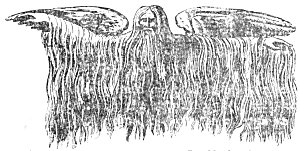We are reminded, by this passage, of the Tomb of Khir-Om, his death, and his rising from the grave, symbolical of restoration of life; and also of the brazen Sea in the Temple at Jerusalem. Herodotus adds: “I impose upon myself a profound silence in regard to these Mysteries, with most of which I am acquainted. As little will I speak of the initiations of Ceres, known among the Greeks as Thesmophoria. What I shall say will not violate the respect which I owe to religion.”
Athenagoras quotes this passage to show that not only the Statue but the Tomb of Osiris was exhibited in Egypt, and a tragic representation of his sufferings; and remarks that the Egyptians had mourning ceremonies in honor of their Gods, whose deaths they lamented; and to whom they afterward, sacrificed as having passed to a state of immortality.
p. 406
It is, however, not difficult, combining the different rays of light that emanate from the different Sanctuaries, to learn the genius and the object of these secret ceremonies. We have hints, and not details.
We know that the Egyptians worshipped the Sun, under the name of Osiris. The misfortunes and tragical death of this God were an allegory relating to the Sun. Typhon, like Ahriman, represented Darkness. The sufferings and death of Osiris in the Mysteries of the Night were a mystic image of the phenomena of Nature, and the conflict of the two great Principles which share the empire of Nature, and most influenced our souls. The Sun is neither born, dies, nor is raised to life: and the recital of these events was but an allegory, veiling a higher truth.
Horus, son of Isis, and the same as Apollo or the Sun, also died and was restored again to life and to his mother; and the priests of Isis celebrated these great events by mourning and joyous festival succeeding each other.
In the Mysteries of Phœnicia, established in honor of Thammuz or Adoni, also the Sun, the spectacle of his death and resurrection was exhibited to the Initiates. As we learn from Meursius and Plutarch, a figure was exhibited representing the corpse of a young man. Flowers were strewed upon his body, the women mourned for him; a tomb was erected to him. And these feasts, as we learn from Plutarch and Ovid, passed into Greece.
In the Mysteries of Mithras, the Sun-God, in Asia Minor, Armenia and Persia, the death of that God was lamented, and his resurrection was celebrated with the most enthusiastic expressions of joy. A corpse, we learn from Julian Firmicus, was shown the Initiates, representing Mithras dead; and afterward his resurrection was announced; and they were then invited to rejoice that the dead God was restored to life, and had by means of his sufferings secured their salvation. Three months before, his birth had been celebrated, under the emblem of an infant, born on the 25th of December, or the eighth day before the Kalends of January.
In Greece, in the Mysteries of the same God, honored under the name of Bakchos, a representation was given of his death, slain by the Titans; of his descent into hell, his subsequent resurrection, and his return toward his Principle or the pure abode whence he had descended to unite himself with matter. In the islands
p. 407
of Chios and Tenedos, his death was represented by the sacrifice of a man, actually immolated.
The mutilation and sufferings of the same Sun-God, honored in Phrygia under the name of Atys, caused the tragic scenes that were, as we learn from Diodorus Siculus, represented annually in the Mysteries of Cybele, mother of the Gods. An image was borne there, representing the corpse of a young man, over whose tomb tears were shed, and to whom funeral honors were paid.
At Samothrace, in the Mysteries of the Cabiri or great Gods, a representation was given of the death of one of them. This name was given to the Sun, because the Ancient Astronomers gave the name of Gods Cabiri and of Samothrace to the two Gods in the Constellation Gemini; whom others term Apollo and Hercules, two names of the Sun. Athenion says that the young Cabirus so slain was the same as the Dionusos or Bakchos of the Greeks. The Pelasgi, ancient inhabitants of Greece, and who settled Samothrace, celebrated these Mysteries, whose origin is unknown: and they worshipped Castor and Pollux as patrons of navigation.

Moe is the founder of GnosticWarrior.com. He is a father, husband, author, martial arts black belt, and an expert in Gnosticism, the occult, and esotericism.





